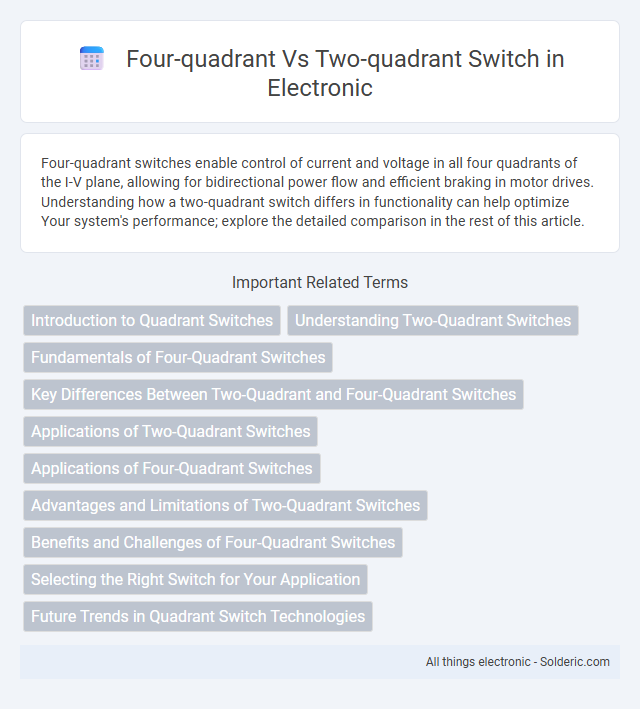Four-quadrant switches enable control of current and voltage in all four quadrants of the I-V plane, allowing for bidirectional power flow and efficient braking in motor drives. Understanding how a two-quadrant switch differs in functionality can help optimize Your system's performance; explore the detailed comparison in the rest of this article.
Comparison Table
| Feature | Four-Quadrant Switch | Two-Quadrant Switch |
|---|---|---|
| Operation Modes | Forward and reverse motoring and braking | Forward and reverse motoring only |
| Energy Recirculation | Supports regenerative braking (energy return) | No energy return; energy dissipated as heat |
| Control Complexity | High - complex control algorithms required | Lower - simpler control mechanisms |
| Applications | Electric drives requiring bidirectional torque and braking | Basic motor drives without reversing braking needs |
| Cost | Higher due to complexity and components | Lower cost, simpler design |
| Switching Elements | Typically uses H-bridge or full-bridge configuration | Uses half-bridge or simpler topology |
Introduction to Quadrant Switches
Quadrant switches control motor direction and braking by managing power flow in multiple operational modes, with four-quadrant switches enabling forward/reverse motoring and dynamic braking across all four quadrants of the torque-speed plane. Two-quadrant switches handle power in only two quadrants, typically forward motoring and regenerative braking, limiting their functionality in reversing applications. Your choice between these switches depends on the required control complexity and application demands for efficient motor operation.
Understanding Two-Quadrant Switches
Two-quadrant switches allow current to flow in one direction while controlling voltage polarity in both positive and negative quadrants, making them ideal for regenerative braking and motor control applications. These switches enable efficient energy recovery by handling power flow in forward motoring and reverse braking modes. Understanding the operation and benefits of two-quadrant switches helps you optimize performance in systems requiring bidirectional voltage control with unidirectional current flow.
Fundamentals of Four-Quadrant Switches
Four-quadrant switches enable bidirectional control of current and voltage, allowing operation in all four quadrants of the voltage-current plane for precise power flow management. Your applications benefit from their ability to handle forward and reverse power flow as well as motoring and braking modes, essential for motor drives and regenerative braking systems. These switches use semiconductor devices like IGBTs or MOSFETs, offering efficient control and energy recovery in dynamic load conditions.
Key Differences Between Two-Quadrant and Four-Quadrant Switches
Two-quadrant switches control current or voltage in two quadrants of the voltage-current plane, enabling either positive voltage with positive or negative current, suitable for applications like regenerative braking without full bidirectional power flow. Four-quadrant switches manage all four quadrants, allowing both voltage and current to be positive or negative, thus providing full bidirectional power flow essential for advanced motor drives and bidirectional converters. The key differences lie in their operational capabilities, with four-quadrant switches supporting complete control over power direction and polarity, while two-quadrant switches offer partial control limited to current or voltage polarity changes.
Applications of Two-Quadrant Switches
Two-quadrant switches are widely used in applications requiring controlled bidirectional current flow but unidirectional voltage, such as motor control systems for deceleration and regenerative braking in electric vehicles. These switches enable energy recovery and improved efficiency by allowing current reversal without changing the voltage polarity. Your systems can benefit from smoother speed control and reduced power loss by integrating two-quadrant switching technology in various industrial automation and power electronics applications.
Applications of Four-Quadrant Switches
Four-quadrant switches are essential in applications requiring bidirectional current flow and voltage control, such as regenerative braking in electric vehicles and advanced motor drive systems. These switches enable energy recovery by allowing current to flow back into the power source, improving efficiency and reducing energy loss. Your systems benefit from enhanced dynamic performance and precise control in industrial automation and renewable energy technologies.
Advantages and Limitations of Two-Quadrant Switches
Two-quadrant switches offer efficient control of current flow and direction within two quadrants of the voltage-current plane, making them ideal for applications requiring regenerative braking and bidirectional current flow, such as DC motor drives. Their advantages include simpler design, lower cost, and ease of implementation compared to four-quadrant switches. However, limitations arise from their inability to handle power flow in all four quadrants, restricting their use in systems requiring full four-quadrant operation and bidirectional voltage control, which can impact your system's performance in energy recovery and dynamic response.
Benefits and Challenges of Four-Quadrant Switches
Four-quadrant switches offer significant benefits including bidirectional current and voltage control, which enhances regenerative braking and energy recovery in motor drives. Their ability to facilitate precise power flow in all four quadrants improves system efficiency and operational flexibility. However, challenges include increased complexity in design, higher costs, and the need for advanced control algorithms to manage switching and reduce electromagnetic interference.
Selecting the Right Switch for Your Application
Selecting the right switch for your application depends on factors such as power direction control, complexity, and cost. Four-quadrant switches allow full bidirectional current and voltage control, ideal for regenerative braking or bidirectional power flow in motor drives. Two-quadrant switches provide unidirectional current flow with voltage reversal capability, suitable for simpler applications with less demanding control requirements.
Future Trends in Quadrant Switch Technologies
Future trends in quadrant switch technologies emphasize increased efficiency and improved energy recuperation in both four-quadrant and two-quadrant switches, with four-quadrant switches gaining prominence due to their ability to handle bidirectional current and voltage in motor control applications. Advancements in semiconductor materials such as SiC and GaN are driving higher switching speeds and thermal performance, enabling wider adoption in automotive and renewable energy systems. Integration of smart controls and IoT connectivity enhances real-time diagnostics and adaptive switching, optimizing performance across diverse dynamic load conditions.
Four-quadrant vs Two-quadrant Switch Infographic

 solderic.com
solderic.com